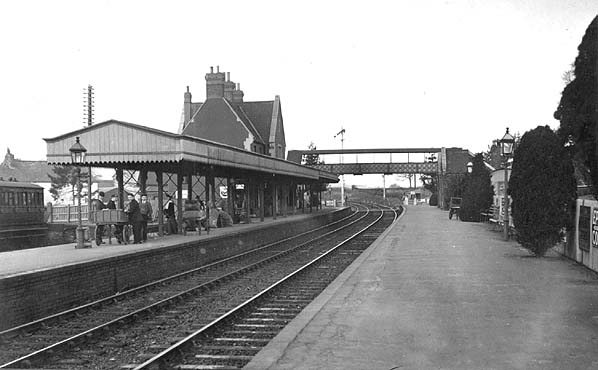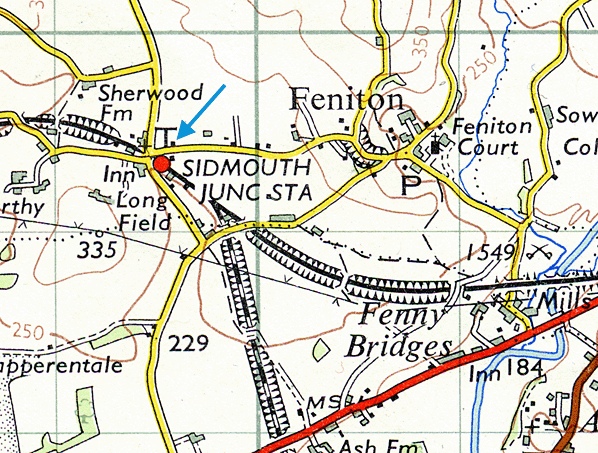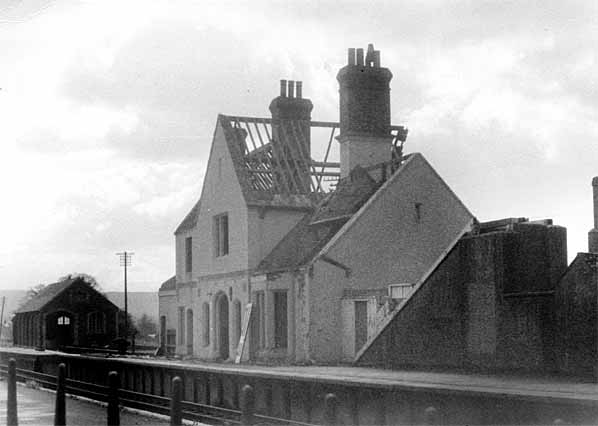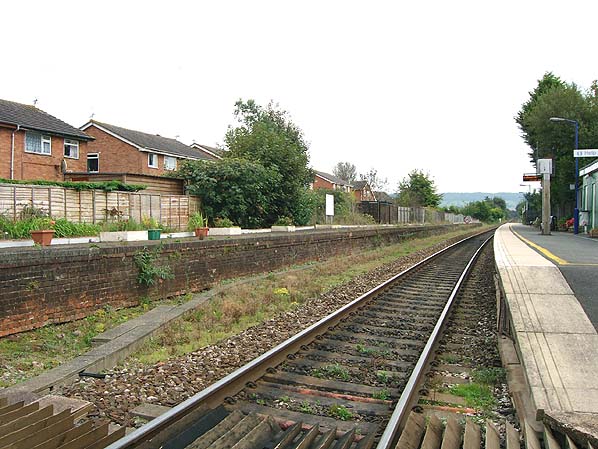|
Notes: When opened the station was sited in the middle of nowhere
which gave the LSWR difficulty in selecting a name. It was originally
called Feniton and renamed Ottery Road on 1.7.1861. It retained
this name until 1868 when it was given the misleading name Ottery
St. Mary. After numerous complaints (the town was five miles
away) it reverted back to Ottery Road two months later. With
the opening of the Sidmouth Railway it was renamed Sidmouth
Junction on 6.7.1874.
The station now gained more importance and the platforms were
extended. Traffic originating at the station had never been
heavy and was negligible once Ottery St. Mary got its own station
on the branch. The station was well used for interchange with
the branch however.
Although local services on the main line were withdrawn on
7th March 1966, Sidmouth Junction survived for another year,
closure coming when the branch lines closed. Just before the
station was due to close a large housing estate was being developed
at Feniton, close to the station and after a long struggle the
station was reopened as Feniton in 1971 using the shortened
former down platform. The station buildings were demolished
and a bus shelter was built on the platform.
BRIEF HISTORY OF THE SIDMOUTH
& BUDLEIGH SALTERTON RAILWAYS
The first railway on Sidmouth was narrow gauge built in connection
with an 1836 dock venture, this was short lived and the dock
was never built. The Sidmouth Railway was authorised in 1862
but the company collapsed after some of the lines earthworks
had been built; it was revived in 1871 and the line finally
opened on 6th July 1874. The station was inconveniently sited
a mile inland; Sidmouth deliberately discouraged the railway
from coming close enough to the sea front in an attempt to put
off trippers, it preferred to remain a select resort, even into
the second half of the 20th century. Sidmouth had been attracting
a select number of visitors for 80 years, especially for winter
residence and the coming of the railway made less difference
than at any other resort in the West Country. The lack of sand
on the beach was also an important consideration as shingle
beaches are always unpopular with family holidaymakers and day
trippers.
The line was built and owned by the Sidmouth Railway Company
but operated on its behalf by the L&SWR with traffic running
down the Otter Valley from Sidmouth Junction to Ottery St. Mary
and Tipton St. Johns and then over the steeply graded section
to Sidmouth. Although traffic was never heavy it remained steady
and was sufficiently high for the Sidmouth Railway to retain
its independence until 1923 when it was absorbed into the Southern
Railway. Initially there was a total of seven trains ran daily
taking 30 minutes for the journey. This reached a peak of 24
services each way in the 1930's
 |
Unlike Sidmouth, the resort of Budleigh Salterton welcomed
the locally sponsored Budleigh Salterton Railway which continued
following the Otter Valley from a junction with the Sidmouth
branch at Tipton St. Johns. It opened on 15th May 1897 with
an intermediate station at East Budleigh and a second added
two years later at Newton Poppleford. Although the company remained
independent until 1912 the line was operated by the London &
South Western Railway who built an extension from Budleigh Salterton
to Exmouth which opened on 1st June 1903 with an intermediate
station at Littleham on the outskirts of Exmouth. Much of the
through London - Exmouth traffic was diverted along the new
line and several through trains round the circular Exeter -
Exmouth - Budleigh - Sidmouth Junction - Exeter route were introduced.
Use of the two branches was encouraged by the introduction of
runabout tickets just before WW1 and the lines were moderately
well used by day trippers from London until the start of WW2.
Passenger numbers on the branch remained healthy well into
the 1950's although rationalisation in the 1960 reduced the
line to little more than a skeleton service with diesel multiple
units being introduced on 4th November 1963. A cross country
service from Cleethorpes - Exmouth was introduced in 1960 but
this only lasted two years. There had never been any industrial
development in Budleigh Salterton and goods traffic was always
correspondingly light. Freight facilities were withdrawn on
27th January 1964. With the draw down of passenger services
the end was inevitable. Through trains were withdrawn at the
end of the 1966 summer season and both branches closed to passenger
traffic on 6th March 1967. Freight traffic to Sidmouth survived
for a further two months with complete closure from 8th May
1967, the track was lifted shortly after closure.
Route map drtawn by Alan Young.
To see the other
stations on the Sidmouth& Budleigh Salterton Railways click
on the station name: Ottery
St. Mary, Tipton
St. Johns, Sidmouth,
Newton Poppleford,
East Budleigh,
Budleigh Salterton
& Littleham
|





 Home
Page
Home
Page

